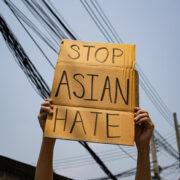FOR the last two years, Asian and Asian Americans have experienced a collective, unfortunate reckoning that has exacerbated the two destructive stereotypes toward the community: the perpetual foreigner and the model minority myth.
As a way to gauge the cultural temperature regarding the Asian community in the United States, the Leading Asian Americans United for Change (LAAUNCH) and The Asian American Foundation (TAAF) led a study designed to “reveal the attitudes and stereotypes towards Asian Americans” in a post-#StopAsianHate world.
The study — called the Social Tracking of Asian Americans in the U.S. (STAATUS) Index — is described as a revolutionary study that seeks to address, understand, and solve the layered causes of anti-Asian racism in the U.S.
“For the past two years, Asian Americans have lived in a period of mourning, anger, fear, and exhaustion from the devastation of COVID-19 and the surge in anti-Asian violence, bigotry, and hate crimes,” the study read. “At a time when attacks against our community have increased, we have seen a corresponding rise in anti-Asian American sentiment among non-Asian Americans, particularly those who are less educated and more marginalized.”
This year’s STAATUS Index is the second report of its kind; last year, the LAAUNCH and TAAF released the inaugural STAATUS Index and compared to that report, it’s clear that there is not much progress in eschewing anti-Asian attitudes.
In 2022, 57% of Americans disagree that “Asian Americans as a group are at least partly responsible for COVID-19,” a decrease from the previous year when 74% disagreed with the statement.
Moreover, according to the STAATUS Index, one thing is made clear: most Americans recognize anti-Asian racism is real.
Fifty-six percent of participants agreed that Asian Americans “are being discriminated against” while 6% say that Asian Americans “are more advantaged compared to other groups.” (The rest either declined to answer or were unsure.)
Only about 29% of Asians feel a sense that they belong or are accepted in the United States, a product of the perpetual foreigner stereotype: that no matter how much work one puts into assimilating into American culture and life, they will always be an outsider.
Furthermore, according to the study, Asians and Asian Americans are the least likely to feel accepted in the U.S. among other racial groups, compared to Black Americans (33%), Latino Americans (42%) and white Americans (61%).
Another key finding found that a majority of Americans still see Asians as the model minority, which incorrectly posits that Asians — who are stereotypically academically smart and successful in corporate America — are well-represented in the American landscape, rendering the need for social programs and resources specific to their community pointless.
The study was conducted through a series of English-language online surveys administered from Feb. 10, 2022 to Feb. 28, 2022 by Savanta Research. Out of a total of 5,113 U.S. residents who participated in the study, the racial breakdown of the study included: 2,840 white; 1,074 Asian; 1,023 Latino/Hispanic, and 888 Black.
(According to LAAUNCH, Native Hawaiians and Pacific Islanders were not included in the study because of their “unique identities and perceptions,” and “further research is needed to analyze…the NHPI community.”)
In addition to race, the study itself breaks down findings by demographic markers like age, gender, and political preference. Notably, 19% of Asian Americans between the ages 18-24 feel that they belong in the U.S., and men (33%) are more likely to feel that they fully belong than women (27%).
Despite the overwhelming consensus that Asian Americans continue to face discrimination, the study also concluded that 70% of Americans consider Asian Americans as important contributors to American excellence via academia, medicine, and the economy.
For years, the Asian American community has been nearly invisible in contemporary conversations about race and race relations in the United States.
Following recent disturbing increases in anti-Asian harassment, violence, and murder, the need for protective solutions is key, and the study found that most people believe that starts with education, changes in media narratives, and further data and research dedicated to the Asian American community.
Interestingly, across all racial groups, 70% of Americans expressed a desire to see more (and better) Asian and Asian American representation in entertainment, which is one of the fundamental forms of media that contribute to public perception.
“Despite these challenges, the prognosis for the future of the Asian American community is positive,” LAAUNCH and TAAF wrote in the report. “Working with Asian American youth, who feel a strong sense of Asian American identity, to build greater pride and belonging will lay the foundation for the next generation of leaders who will shape both perceptions and policy.” (Klarize Medenilla/AJPress)







